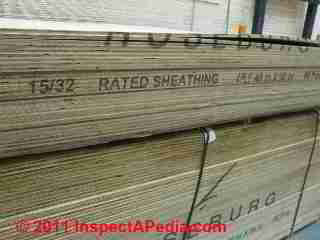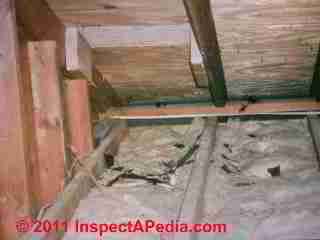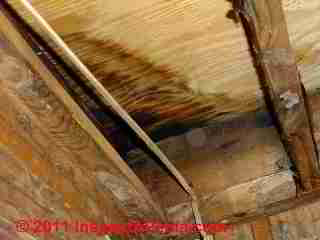 Plywood Products used in Home Construction: Floor, Wall, Roof Decking & Sheathing
Plywood Products used in Home Construction: Floor, Wall, Roof Decking & Sheathing
- POST a QUESTION or COMMENT about plywood sheathing & uses in construction
Plywood roof, wall or floor sheathing:
This article defines and illustrates plywood building products used in roof and wall sheathing and in floor construction.
This article series describes wood products used in construction including engineered lumber, OSB, and Plywood products.
Our page top photo shows a stack of nominal half-inch plywood sheathing (actual 15/32" in thickness) stacked at a Home Depot® building supply store.
InspectAPedia tolerates no conflicts of interest. We have no relationship with advertisers, products, or services discussed at this website.
- Daniel Friedman, Publisher/Editor/Author - See WHO ARE WE?
Definition & Characteristics of Plywood
 "Plywood" or traditional plywood sheets, typically 4' x 8' in dimension and of varying thicknesses, typically from 3/16" up to 3/4" or more, is constructed of veneers of wood glued together, but each layer of wood is placed at right-angles to those on either side.
"Plywood" or traditional plywood sheets, typically 4' x 8' in dimension and of varying thicknesses, typically from 3/16" up to 3/4" or more, is constructed of veneers of wood glued together, but each layer of wood is placed at right-angles to those on either side.
Our photo (left) shows 1/2-inch CDX plywood installed as exterior wall sheathing on a home being constructed in Minneapolis, Minnesota.
[Click any image to see an enlarged, detailed version]
Plywood sheets are named according to the sheet thickness, the quality of its exterior or exposed veneers (A = clear, no knots, C/D - construction grade, etc), and its thickness.
Plywood products are also selected for interior or exterior use based on the weather resistance of the glues used to glue the veneers together (exterior plywood uses exterior glues), and finally on the condition of interior veneers or plies of wood.
Plywood used for floor sheathing or underlayment beneath carpeting, for example, is selected without interior voids so that someone's shoe-heel won't puncture through a clear top veneer of wood into a hidden void below.
History & Age of Plywood Building Products
As we also discuss at FRAMING MATERIALS, AGE, TYPES and at age of SHEATHING, PLYWOOD:
PLYWOOD Roof, Wall, Floor Decks & Sheathing (1905 - present as a construction material in North America) is sheet material made of thin veneers of wood that are laid with wood grains in alternating direction, glued, heated, and pressed together. Interior plywood is generally glued with urea formaldehyde based glues; exterior plywood and marine plywood use phenolic formaldehyde glues and are water resistant.
Our photo (left) shows how a small section of damaged plywood roof sheathing was repaired.
While modern plywood products use a variety of glues, heat, and pressure to produce the product, plywood has been around at least since 3500 BC when a glued-veneer version was produced in Egypt.
The furniture industry has had a long history of gluing thin fine-wood veneers to a cheaper wooden base - a process similar to the production of plywood itself.
The invention of the rotary lathe (ca 1850) by Immanuel Nobel (1801 - 1872) is what made modern plywood possible by permitting manufacturers to cut large thin (but thicker than wood veneers) sheets of wood from logs. The wood sheets are placed at right angles to one another and glued together.
The cross-grain construction combined with glue produces a strong, uniform material that is used for both enclosure and for structural stiffness in frame construction of building walls and roofs.
Our plywood roof sheathing photo (left) illustrates 1960's era 1/2-inch roof sheathing plywood that was being removed during a building expansion project.
The properties of plywood, including its tolerance to weather exposure (marine plywood) depend on the glues and finishes used. Both softwood and hardwoods are used in plywoods, and fine wood veneer finishes are also available (for furniture use).
The first plywood made in the Western U.S. was produced by the Portland Manufacturing Company in Oregon in 1905, a company founded four years earlier by Gustav A. Carlson, F.S. Doernbecher, and M.L. Holbrook.
Peter Autzen bought out Doernbecher and Holbrook. It was Autzen's son, Thomas, who made key progress solving problems with bonding the veneers together.
Originally the Portland Manufacturing company had produced fruit baskets, crates, and drums, experience which we pose gave the owners familiarity with cutting thin strips of wood (baskets) that remained flexible for use in a manufacturing process.
Their plywood was exhibited at the 1905 Worlds' Fair in Portland, Oregon. Interestingly, the first exhibition of plywood as a building product in the Northwest was in a log structure, the Forestry Building in Portland, OR where it was displayed until that building burned in 1964.
The stained plywood roof sheathing (left) was discovered during a home renovation project in which a flat roof was to be torn off for an addition.
In 1924 plywood sales were still primarily to door producers, but by 1928 the company had increased production and plywood was being used in automobile bodies. In that year the Pacific Coast Plywood Manufacturers, Inc. (PCPM)was formed jointly with Elliot Bay Mill Co. (Seattle), Walton Veneer Co. (Everett WA), and Washington Veneer Co. (Olympia WA). But PCPM was dissolved after the 1929 Stock Market crash.
The appeal and success of plywood as a building material are based on quite a few factors including increased construction speed (consider nailing up 4x8 sheets of plywood versus individual tongue and groove exterior building sheathing or roofing), product uniformity and strength, and the reduction of waste compared with cutting sheathing boards out of logs.
Also see FIRE RETARDANT PLYWOOD.
Paul DeBaggis points out that
Plywood and particle board are used in cases where today's more stringent codes require more diaphragm walls for wind loads. In some low wind zones, and with the correct corner bracing, exterior walls may be sheathed with styrofoam sheets. [2] - personal correspondence 12/2013
Definition & Characteristics of MDO Plywood
"MDO" plywood (Medium Density Overlay) is constructed of a core of overlapping veneers of wood, but with a surface layer of medium density fiber. The resulting product has a smooth surface. MDO plywood can be used once as a concrete form material, but should not be re-used for that purpose.
See TRIM, EXTERIOR CHOICES, INSTALLATION for a discussion of use of MDO plywood for use on building soffits.
Definition & Characteristics of HDO Plywood
"HDO" (High Density Overlay) plywood is similar to MDO Plywood described just above. HDO plywood also is constructed wit a core of overlapping wood veneers, but instead of using a medium density fiber for its external surfaces, HDO plywood uses a high-density fiber exterior. HDO plywood products, having a harder exterior surface, can be re-used several time for concrete forms.
APA (The Engineered Wood Association) provides an HDO/MDO Plywood Product Guide that offers details about these products.
The design and content found at InspectAPedia.com® are © Copyright protected, All Rights Reserved. Contents of this website may not be copied in any form. Our main website topics listed at page top or at the MORE READING links at the bottom of this article provide in-depth, un-biased, expert information on building defect inspection, diagnosis, & repair.
...
Continue reading at FRT PLYWOOD for information about fire retardant treated plywood, or select a topic from the closely-related articles below, or see the complete ARTICLE INDEX.
Or see these
Recommended Articles
- DEFINITIONS of ENGINEERED WOOD OSB LVL etc
- FIRE RETARDANT PLYWOOD
- SHEATHING, FIBERBOARD
- SHEATHING, FOIL FACED - VENTS
- SHEATHING, GYPSUM BOARD
- SHEATHING, OSB
- SHEATHING, PLYWOOD
- SHEATHING, EXTERIOR PRODUCT INDEX
- STRESS SKIN / STRUCTURAL INSULATED PANELS (SIPs)
Suggested citation for this web page
SHEATHING, PLYWOOD at InspectApedia.com - online encyclopedia of building & environmental inspection, testing, diagnosis, repair, & problem prevention advice.
Or see this
INDEX to RELATED ARTICLES: ARTICLE INDEX to BUILDING STRUCTURES
Or use the SEARCH BOX found below to Ask a Question or Search InspectApedia
Ask a Question or Search InspectApedia
Try the search box just below, or if you prefer, post a question or comment in the Comments box below and we will respond promptly.
Search the InspectApedia website
Note: appearance of your Comment below may be delayed: if your comment contains an image, photograph, web link, or text that looks to the software as if it might be a web link, your posting will appear after it has been approved by a moderator. Apologies for the delay.
Only one image can be added per comment but you can post as many comments, and therefore images, as you like.
You will not receive a notification when a response to your question has been posted.
Please bookmark this page to make it easy for you to check back for our response.
IF above you see "Comment Form is loading comments..." then COMMENT BOX - countable.ca / bawkbox.com IS NOT WORKING.
In any case you are welcome to send an email directly to us at InspectApedia.com at editor@inspectApedia.com
We'll reply to you directly. Please help us help you by noting, in your email, the URL of the InspectApedia page where you wanted to comment.
Citations & References
In addition to any citations in the article above, a full list is available on request.
- In addition to citations & references found in this article, see the research citations given at the end of the related articles found at our suggested
CONTINUE READING or RECOMMENDED ARTICLES.
- Carson, Dunlop & Associates Ltd., 120 Carlton Street Suite 407, Toronto ON M5A 4K2. Tel: (416) 964-9415 1-800-268-7070 Email: info@carsondunlop.com. Alan Carson is a past president of ASHI, the American Society of Home Inspectors.
Thanks to Alan Carson and Bob Dunlop, for permission for InspectAPedia to use text excerpts from The HOME REFERENCE BOOK - the Encyclopedia of Homes and to use illustrations from The ILLUSTRATED HOME .
Carson Dunlop Associates provides extensive home inspection education and report writing material. In gratitude we provide links to tsome Carson Dunlop Associates products and services.




